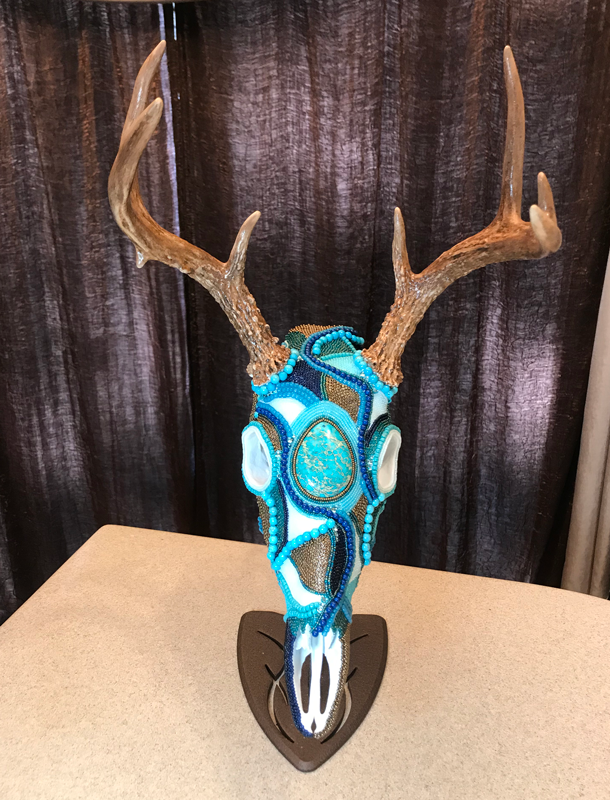Unconventional Beauty: Different Styles of Deer Skull Art

Intro
Deer skull art has evolved into a unique and captivating form of artistic expression, blending the rustic charm of nature with intricate designs and techniques. This form of art is not only about celebrating the beauty of wildlife in a respectful and creative way but also about pushing the boundaries of conventional aesthetics and traditional taxidermy options.
From beaded masterpieces to metallic finishes, deer skull art has found its way into various styles, each telling a story of its own. In this blog post, we delve into the different styles of deer skull art, exploring their origins, significance, and how they’ve been reimagined into modern masterpieces.
The Origins and Significance of Deer Skull Art
Tracing the roots of deer skull art takes us back to times when the natural and spiritual realms were deeply intertwined in the daily lives of ancient peoples. This art form’s genesis is found within the rituals and cultural practices of early civilizations where animal skulls, especially those of deer, were revered objects. They were used not only as tokens of power and survival but also as sacred items in ceremonies, embodying respect for the animals and the natural world at large. Indigenous cultures have been particularly influential in the evolution of deer skull art, embedding their profound spiritual beliefs and their respect for nature into each piece.
The deer has been a pervasive symbol across myriad cultures, often associated with qualities such as gentleness, agility, and spiritual enlightenment. Its depiction in art, especially through its skull, has been a medium for expressing themes of regeneration and connection to the earth, echoing the animal’s role in nature as a creature of significant spiritual and physical presence. This historical backdrop sets the stage for the modern interpretations of deer skull art, where artists continue to draw on these rich traditions while incorporating contemporary techniques and perspectives, thereby keeping the dialogue between past and present, tradition and innovation, alive and vibrant.
The Intricacies of Beaded Skull Art
Delving into the realm of beaded skull art reveals a world where precision meets creativity, transforming deer skulls into ornate treasures. Artists painstakingly apply thousands of tiny beads, one at a time, to cover the skull’s surface. This process is not for the faint-hearted; it demands immense patience, steady hands, and an eye for detail. The beads, each a small component of the bigger picture, come together in a mesmerizing display of color and pattern. These designs can range from simple, elegant motifs to complex, symbolic compositions that draw inspiration from a variety of cultural backgrounds.
Beaded skull art is a testament to the artist’s dedication, breathing new life into what was once a symbol of the end. It juxtaposes the natural ruggedness of the skull with the refined beauty of the beads, creating a piece that is both visually stunning and rich in meaning. The resulting artwork transcends its origins, becoming a luxurious and almost ethereal object that captivates and enchants. Through the meticulous artistry of beadwork, deer skulls are endowed with a new identity, bridging the gap between traditional craft and contemporary art form.
Metallic Finishes and Modern Interpretations
In the contemporary landscape of deer skull art, metallic finishes stand out for their ability to blend age-old tradition with modern aesthetics. Artists meticulously apply metallic beads, gold, silver, and copper leafing and copper sheeting alongside metallic paints, to craft pieces that shimmer with a contemporary elegance. This technique emphasizes the intricate details and natural textures of the deer skull, creating a striking contrast between the raw beauty of the bone and the refined gleam of metal. Such artworks have a commanding presence, embodying a fusion of natural grace and industrial chic that captivates and charms.
The application of metallic finishes transforms these relics of the wild into luxurious objects of art, suitable for the most sophisticated settings. This style appeals to those who appreciate a modern twist on traditional motifs, offering a bold statement piece that bridges the gap between the natural world and contemporary design. By incorporating metallic elements, artists give deer skull art a new dimension of allure, making each piece a testament to the innovative spirit that defines this unique form of artistic expression.
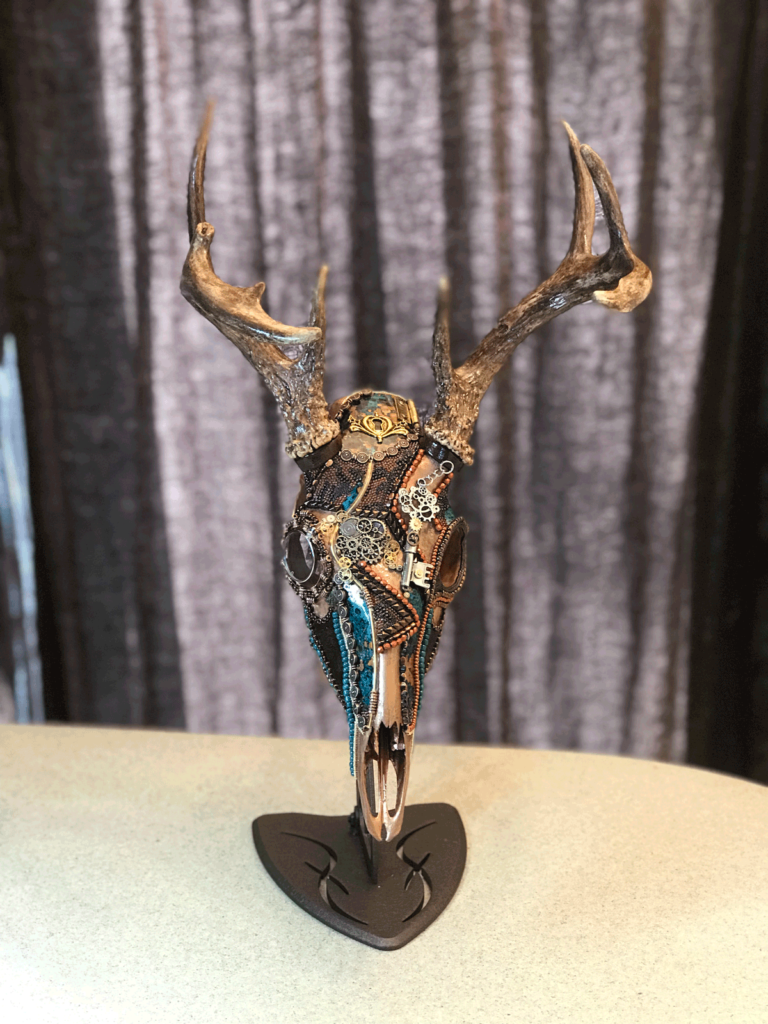
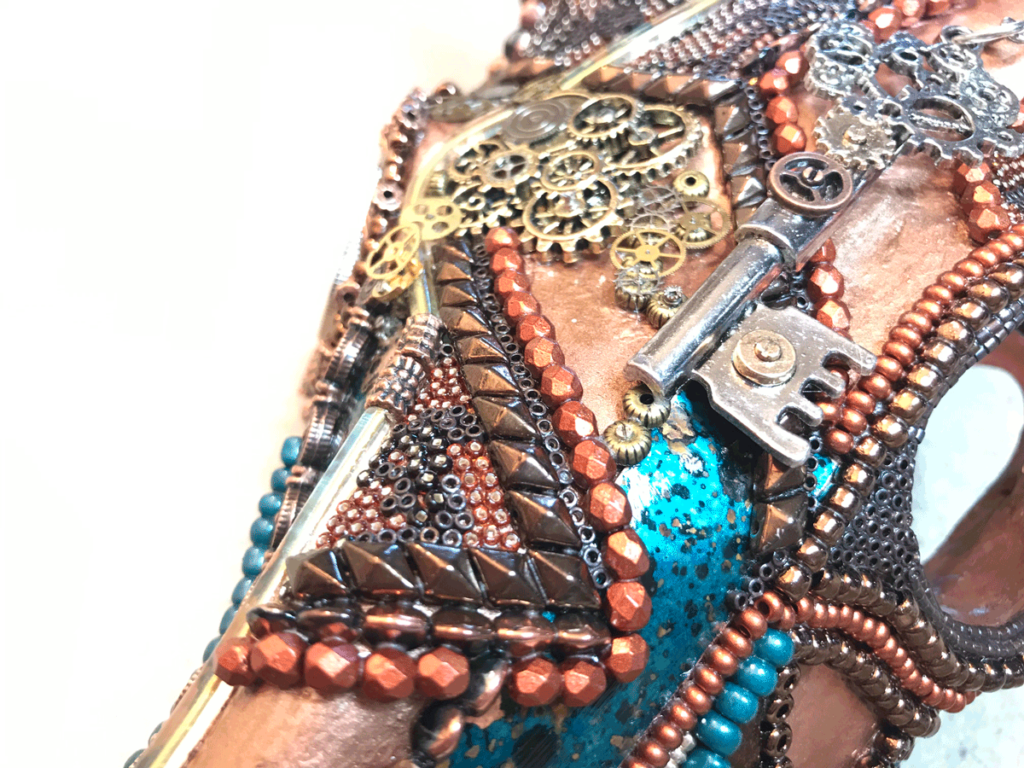
Carved Deer Skull Art: A Testament to Craftsmanship
Carved deer skull art serves as a remarkable display of artistic dedication and skill, where the artist uses the skull as a delicate canvas for elaborate designs. This form requires a profound knowledge of both artistry and the anatomical features of the skull, ensuring that each engraving complements its natural contours and textures. Artists engage in a meticulous process, carefully etching detailed patterns, wildlife scenes, or symbolic imagery directly into the bone. These carvings can be deeply personal, reflecting the artist’s insights, or they can pay homage to the cultural and spiritual significance of the deer within various traditions.
The intricate details achieved through this method transform the skull into a piece of art that transcends its origins, highlighting the intersection of natural beauty and human creativity. With each carved line and curve, the artist not only showcases their adeptness but also breathes new life into the once-living canvas, offering a modern homage to the ancient practices of celebrating wildlife and nature. This style of deer skull art underscores the enduring appeal of manual craftsmanship in an increasingly digital world, inviting viewers to appreciate the tactile and time-honored techniques that create such captivating works.
The Ethereal Charm of Painted Deer Skulls
In the domain of painted deer skulls, artists wield their brushes to cast a spell of creativity, employing an array of colors to dress these relics of the wilderness in visual narratives. This method of embellishment allows for an endless spectrum of artistic expression, from the depiction of serene forest scenes and delicate flora to the crafting of bold, abstract patterns that challenge the viewer’s perception. The choice of color palette plays a crucial role, with some creators leaning towards soft, muted tones to evoke a sense of tranquility and others using vibrant, contrasting hues to inject energy and dynamism into their work. The paint transforms the skull, no longer a simple remnant of the past but now a canvas that reflects the artist’s vision and emotions.
Through the strokes and shades, painted deer skulls become more than just objects of visual appeal; they serve as vessels of storytelling, encapsulating tales of the wilderness and the cycle of life. This style of deer skull art, therefore, not only showcases the aesthetic flexibility of the medium but also allows artists to connect with viewers on a deeply personal level, sharing stories of nature’s enduring beauty and mystery through the transformative power of paint.
The Role of Deer Skull Art in Home Decor
Incorporating deer skull art into home decor offers a distinct and impactful statement that blends the raw essence of nature with refined artistic expression. Such pieces serve as conversation starters, imbuing spaces with an air of mystery and allure that is hard to replicate with traditional decor items. The adaptability of deer skull art to various interior design styles is one of its most compelling attributes. For a rustic or cabin-style setting, a naturally finished or carved deer skull can emphasize the connection to the outdoors, adding authenticity and warmth.
In contrast, a skull adorned with metallic finishes or vibrant paints can stand as a striking art piece in more modern or eclectic interiors, bringing a bold juxtaposition of the organic and the avant-garde. For those curating a more minimalist aesthetic, a deer skull with simple, elegant beadwork can introduce texture and interest without overwhelming the space. This versatility makes deer skull art a favored choice among those looking to infuse their homes with a sense of uniqueness and personal touch. As this form of art gains traction in interior design, it prompts a deeper appreciation for the intricate balance between art, nature, and the spaces we inhabit, inviting homeowners to explore new dimensions of style and expression.
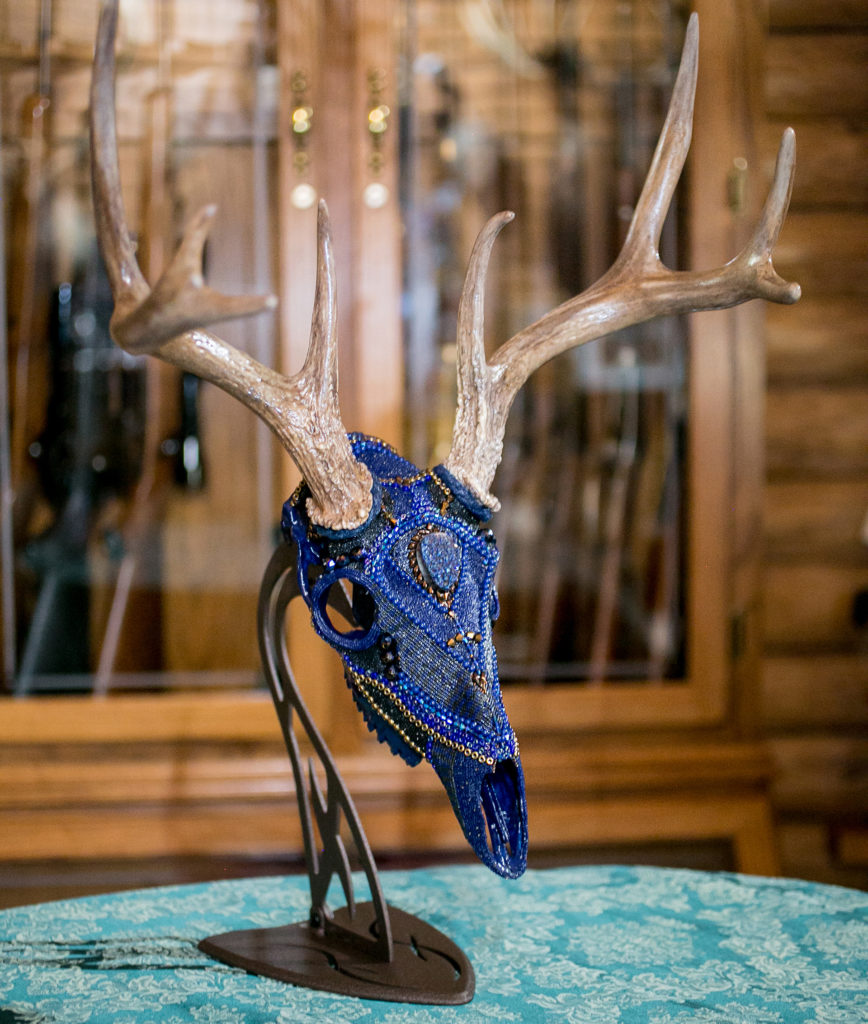
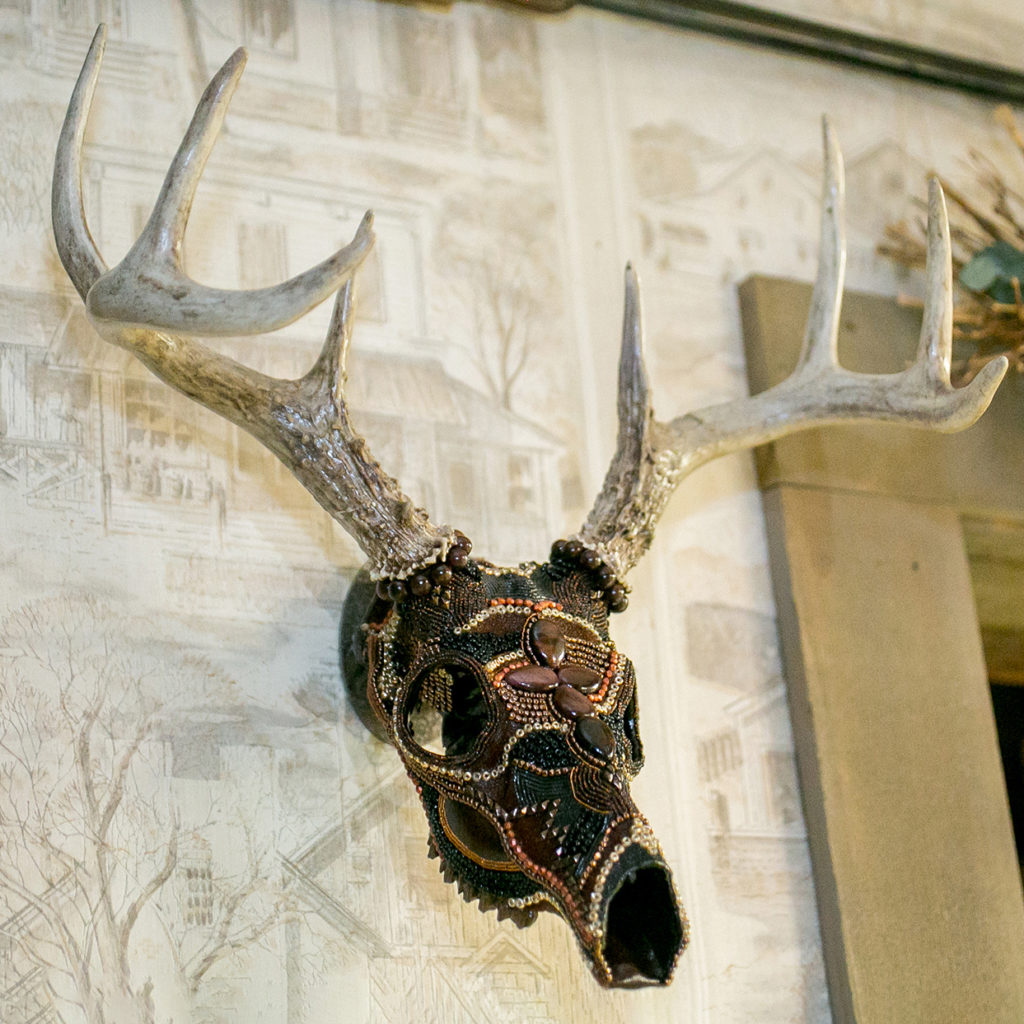
Ethical Considerations and Sourcing
The growing allure of deer skull art brings to the forefront the critical importance of ethical practices in sourcing materials. Artists and collectors alike are increasingly prioritizing the acquisition of skulls through means that do not harm wildlife populations or ecosystems. This involves obtaining skulls from animals that have died of natural causes, those harvested in controlled and legal hunting activities that contribute to population management, or from farms where animals are raised for various purposes.
Such measures ensure that the art created is not only visually striking but also ethically sound, reflecting a deep respect for the creatures that inspire it. It is a commitment to sustainability and conservation, demonstrating that art can be both beautiful and conscientious. By supporting artists who adhere to these ethical standards, collectors contribute to a culture of respect and responsibility towards nature, fostering a market where art thrives in harmony with environmental stewardship. This approach not only enriches the narrative behind each piece but also aligns with broader values of wildlife preservation and ethical artistry, making each artwork a symbol of beauty and moral integrity.


